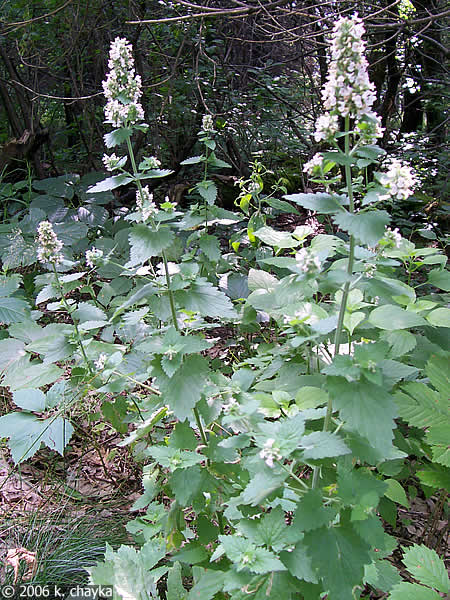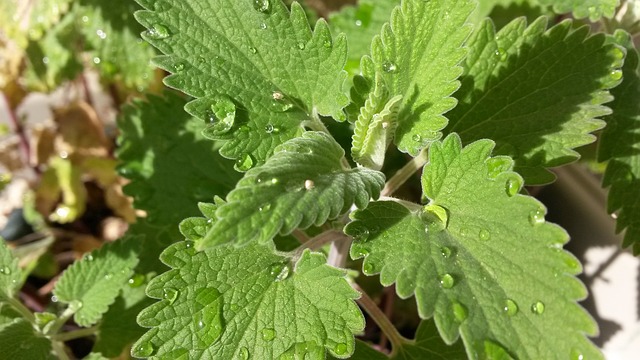Catnip - Nepeta cataria
Family - Lamiaceae, the mint family
Table of Contents
Common Names
Catnip is also commonly called Catmint, Catswort, Catnep, and Field Balm
Catnip was one of the first plants I found when I first moved to South Dakota. I remember being so pleased. Living on the road for 15 or 20 years so many herbs had to be purchased. The big surprise was how abundant Catnip was in the area. A native to the Black Hills region, it was everywhere. With great delight I began deepening my relationship with the plant through exploration, experimentation and use.
When using plants as medicine it’s all about relationship. The more comfortable we are with the energy and uses of each plant, the better and more effectively we can employ them. I like to do this one plant at a time.
Catnip isn’t a new plant. It’s another of those herbs that’s been used for centuries. Gentle enough for children and infants, yet potent enough for adults. No wonder our fore-mothers used it so often.
Description
Catnip is a member of the mint family. Usually growing between 2 to 3 feet tall, it can be fount up to 6 feet tall in ideal conditions. The plant has the typical square stems and alternate leaves of the mint family.
The flowers appear in swirls of white to light pink terminal flower clusters. Although sometimes they are darker in color with violet or purple markings. Catnip usually flowers in late spring or early summer. If trimmed they can be brought to flower up to three times in a season, depending on the weather and conditions.
The whole plant is covered with a soft downy felt. Giving the plant a slightly gray green hue, especially on the undersides of the leaves. The leaves are triangular, lightly heart shaped near the stem and roundly serrated along the edges.
Catnip has a distinctive smell that is lightly minty with an unusual after smell. Once you’ve experienced it, you won’t forget it. It’s this peculiar smell that drives cats crazy.

Part Used
Arial parts are harvested when the plant is just beginning to flower. Cut the whole above ground portion 2/3 down, leaving 1/3 of the plant untouched. Tie in bunches and hang upside down to dry. Once dried discard the stems.
Fresh plant tinctures or extracts can be made with freshly harvested plants.
Click here for more information about herbal tinctures, extracts and glycerites.
Primary Chemical Constituents of Catnip
Catnip has a varied and complex chemistry that includes nepetalactones, essential oil, caryophyllene, caryophyllene-oxide, rosmarinic acid, humulenes, farnesenes, piperitone, thymol-methyl-ether, camphor and more.
Medicinal Properties
Antispasmodic, anti-inflammatory, carminative, nervine, sedative, diaphoretic and astringent.
Medicinal Uses of Catnip
Catnip is a classic children’s remedy used to treat colds, flu, fever, anxiety, stomachache, restlessness, flatulence, diarrhea, colic and sore throat. It is safe and effective for children, babies and nursing mothers. Although not recommended for during pregnancy because it can encourage the menstrual flow.
For adults catnip works as a gentle relaxant to sooth the nerves, settle the digestive system, and relieve cramping due to lower abdominal distress or menstruation.

Internally, Catnip tea, tincture or glycerite acts as a reliable mild sedative. Effective for children even at their fussiest. Especially when they are ill or upset.
Combine Catnip with fennel for stomach upset or colic. Or with Elder flowers and Yarrow to bring down a fever. A mixture of Elder flowers, Yarrow and Catnip is supportive at the first sign of any infection or eruptive kind of illness like chicken pox. Catnip mixes nicely with Lavender flowers, Chamomile and Lemon Balm for the fussy and over stimulated infant of toddler. Although, I have also used this on temperamental teenagers with good success.
A nice teething formula can be made as a tincture with Chamomile, Catnip, Lemon Balm, Lavender. Give the suffering person about 20 drops as often as every 2 hours to reduce the pain and inflammation associated with teething. As a bonus the child also gets a little rest, as does the mother.
Catnip tea or tincture can be taken by a nursing mother to help relieve colic for her baby. Plus she gets a little relief herself.
Catnip alone or combined with fennel, and rose hips or rose flowers is a lovely remedy for diarrhea for child or adult.
When used externally, catnip is par excellence as an insect repellent. Mixed with Pennyroyal herb and Geranium it will repel just about anything that’s bothering you. I like to keep Catnip and Pennyroyal planted around the front yard and in the garden to deter the mosquitoes, flies and other pests.
The infused oil used externally or in the bath to helps ease achy muscles. To help relieve colic and stomach cramps in fussy babies try massaging catnip infused oil or applying an herbal infusion as a compress to the abdomen.
Preparations an Dosage Suggestions
Catnip is an extremely versatile herb. And it is available in a variety of preparations, with tea, infusion, tincture, infused oil and glycerites are probably the most popular. Catnip essential oil is available if you look for it. However, the essential oil tends to cause skin sensitivity or dermatitis in children and susceptible adults.
The tea is made by steeping 1 tablespoon of dry herb per cup of boiling water. Leave covered for 10 to 15 minutes then strain. The suggested dosage for infants is 10 to 30 drops. Or up to 3 cups per day for older children. Give 10 to 30 drops of the tincture up to 4 times per day.

Catnip Products Available at Wonderment Gardens.
Below is a list of products at Wonderment Gardens that contain garden grown and harvested Catnip.
Interactions and Contra-indications
Catnip is contra-indicated during pregnancy because it can stimulate the menstrual flow. The essential oil has been known to cause contact dermatitis to small children and those with sensitive skin.
History and Folklore of Catnip
As we talk about Catnip, let’s not forget about the Kitty Cats. After all its how catnip got its name. The plant has a narcotic effect on our friendly felines that makes them go nuts for it. Dried catnip is put into toys and balls for them to enjoy. By the way if a cat doesn’t like the catnip you purchased, it’s probably old, with its medicinal value diminished.
Recipe
Babies Colic Tea
- 2 parts Catnip
- 1 part Chamomile
- 1 part Fennel
Mix together and steep 1 tablespoon in 1 cup water. Leave covered for 10-15 minutes and strain. Give to infants by dropper or make an herbal compress by soaking a towel or rag in the infusion and placing on the baby’s abdomen.
The Following are affiliate links. That means, if you purchase a product through one of the links, I make a commission at no additional cost to you. I appreciate it each time you click on or make a purchase from one of my links. Thank you for your support.
Here's where you can get quality catnip
References
References
Romm, Aviva Jill. Naturally Healthy Babies and Children, Berkley, Ca; Celestial Arts, 2003
Moore, Michael. Medicinal Plants of the Mountain West, revised and expanded edition, Santa Fe, NM; Museum of New Mexico Press, 2003
Gladstar, Rosemary. Family Herbal, Massachusetts; Storey Books, 2001
Disclaimer
The statements and ideas presented here are not intended to diagnose, treat, cure, or prevent any disease or condition. They have not been evaluated by the FDA. All ideas presented are for the sole purpose of education. To help you take control of your own health. If you have a health concern or condition, consult a physician. We suggest that you always consult a medical doctor before modifying your diet, using any new product, drug, supplement, or doing any new exercises.
These statements and products have not been evaluated by the FDA. They are not intended to diagnose, treat, cure, or prevent any disease or condition. If you have a health concern or condition, consult a physician. Always consult a medical doctor before modifying your diet, using any new product, drug, supplement, or doing any new exercises.
Herbs taken for health purposes should be treated with the same care as medicine. Herbal remedies are no substitute for a healthy diet and lifestyle. If you are serious about good health, you’ll want to combine diet, exercise, herbals, a good relationship with your doctor and a generally healthy lifestyle. No one of these will do it alone.
This information is designed to be used as part of a complete health plan. No products are intended to replace your doctor’s care, or to supersede any of his/her advice or prescriptions.


Thank you for some other informative website. Where else may I am getting that kind of information written in such an ideal manner?
I have a project that I am simply now running on, and I have
been at the look out for such info.